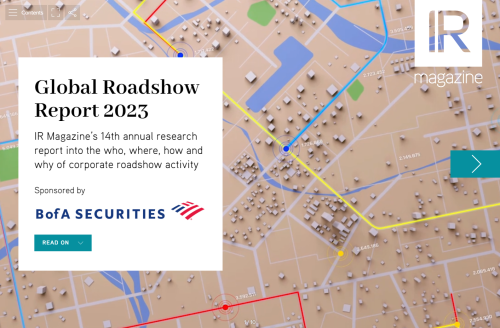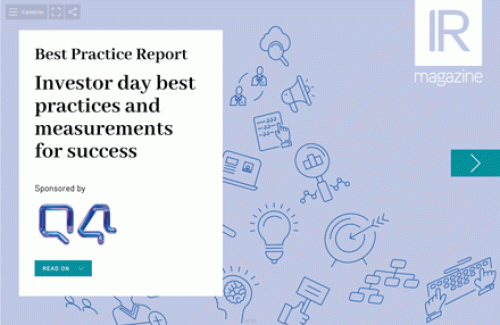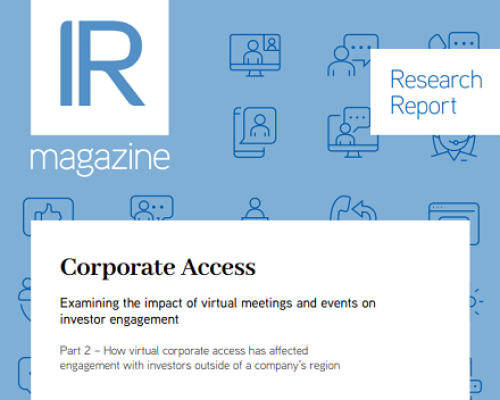I never set out to be in investor relations; it somehow fell into my lap – a familiar story to many, I’m sure. My own journey happened after years in strategic financial planning, budgeting and various finance positions. My CFO tapped me to move into IR after working closely on several projects that incorporated my financial, creative and project management skills.
In 2009 my first investor day experience was supporting the CFO in his presentation development. It was the first time the company had ever held an investor day and right at the start of the financial crisis. The financial presentation was largely focused on the past as the company was only 18 months post a merger of equals. Each speaker created his/her own presentation, which – as one might imagine – resulted in a very siloed story. It was clear that our communications lacked a holistic message.
The following year, still in the midst of a full-blown financial crisis, a new CEO prompted a ‘redo’ so we hosted another investor day. The messaging was still rather siloed, no real guidance was provided and it was more of a show-and-tell with the new management team – perhaps not the best use of our time and resources.
In 2015, after a five-year investor-day hiatus, most of the fallout from the downturn had been dealt with and the company was on better footing. But with all of the repairs to the financial position in our rearview mirror, investors were now clamoring for a growth plan.
The years prior had been spent in turmoil dealing with the company’s ‘sins’ from the past. Quarter after quarter the story kept getting worse and our stock tanked alongside our investment grade ratings. Clearly, investors needed a great deal of transparency, disclosure, reassurance and evidence of execution to prove that we had overcome the issues.
For the first time in the company’s history we were going to give long-term guidance. It felt like we were all holding hands together jumping off a cliff. As well as having confidence in the forecasting process, we had to have confidence in our ability to execute.
Looking back to previous investor days, it was clear we needed to approach this event differently. The most important change was the need to coalesce around a single unified message. I was charged with developing the communication strategy and found myself at the hub of these historically disconnected messages.
We started by conducting a perception study: we needed honest and candid feedback from the investment community. It was important for management to hear it from the horse’s mouth rather than just through the IR team. This helped us solidify the all-important investment thesis so we could then build a message tree to support that thesis. For months I worked with the different speakers and their teams to build a cohesive story and supporting slides that fit together like a puzzle.
The message was well received by investors as demonstrated by the reports published the next day. That’s the thing about investor days: you always get a report card by way of sell-side notes published after the event.
Fast forward three years to the next investor day. It was time to report on our previous long-term targets and provide new ones. Once again, we conducted a perception study as it was important to get that report card to tell us where we had improved and where we still had work to do.
While our message wasn’t drastically different from the previous three years, we wanted to instill in investors that we were still on the path to success. We developed a theme to emphasize the direction of the company, which had nothing to do with the industry but everything to do with how we wanted investors to view our stock. This became the glue that held the story together and was also how I was able to quickly get everyone on the same page internally.
Everything went off without a hitch: the team was seasoned and knew what was on the line.
Today, of course, it’s all moved online. Taking my learnings from the past and combining that with our investment community research on virtual day preferences, I’ve compiled five key takeaways to help you plan a successful virtual investor day.
1. Investor days are OUT, investor workshops are IN
Investors will not pay attention to their computer screens for more than a few hours. That means your message has to be tight, well constructed, effective and engaging. Investors who participated in our research indicated that they prefer it to be two to three hours, max, including Q&A.
2. Internal orchestration of the message will be challenging
Orchestrating your team internally will be very different from walking down the hall to ask someone a question. It will require extensive planning to get the message just right. If you have only a few hours to cover the strategic direction of your company, not everyone will get a turn to speak. Narrowing down your message to the most salient points is more important than ever.
3. The possibility of a larger audience
The stakes are still high, and these events need to come off as well as in-person events, which is harder to do over a computer screen. And you are likely to have a larger audience based on feedback from companies that have already hosted these virtual events.
4. Q&A can be tricky but is still very important
Adding another layer of complexity by allowing viewers to ask questions either live or in advance is just another thing to consider. Q&A is still essential. Events will need to be interactive like an in-person investor day, but don’t leave it all to the end. Weaving it into the event will help maintain interest.
5. Start with the end in mind
Importantly, when thinking about messaging for a virtual investor day, start with the end in mind. After an investor day, sell-side analysts will write reports about the event. I always ask: what do you want your headlines of the analysts’ reports to say? It’s a very quick way to boil down the most important message. If after the event these reports say exactly what you intended, then you have earned an A+.
Sandi Meeks is managing director of StoryLign at Rivel










